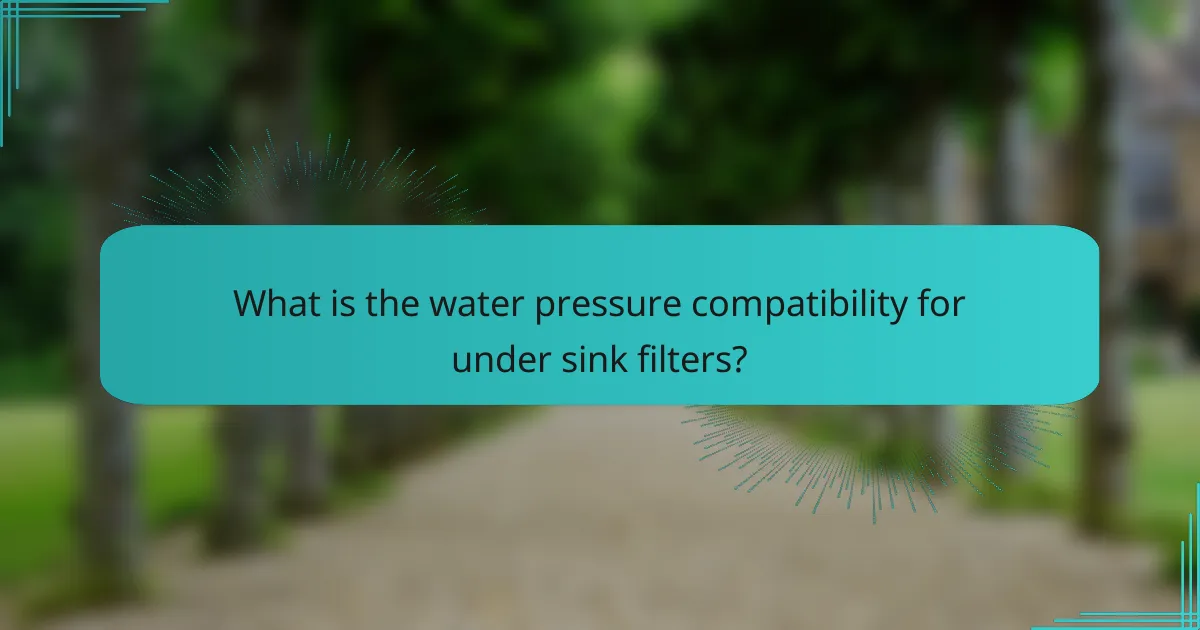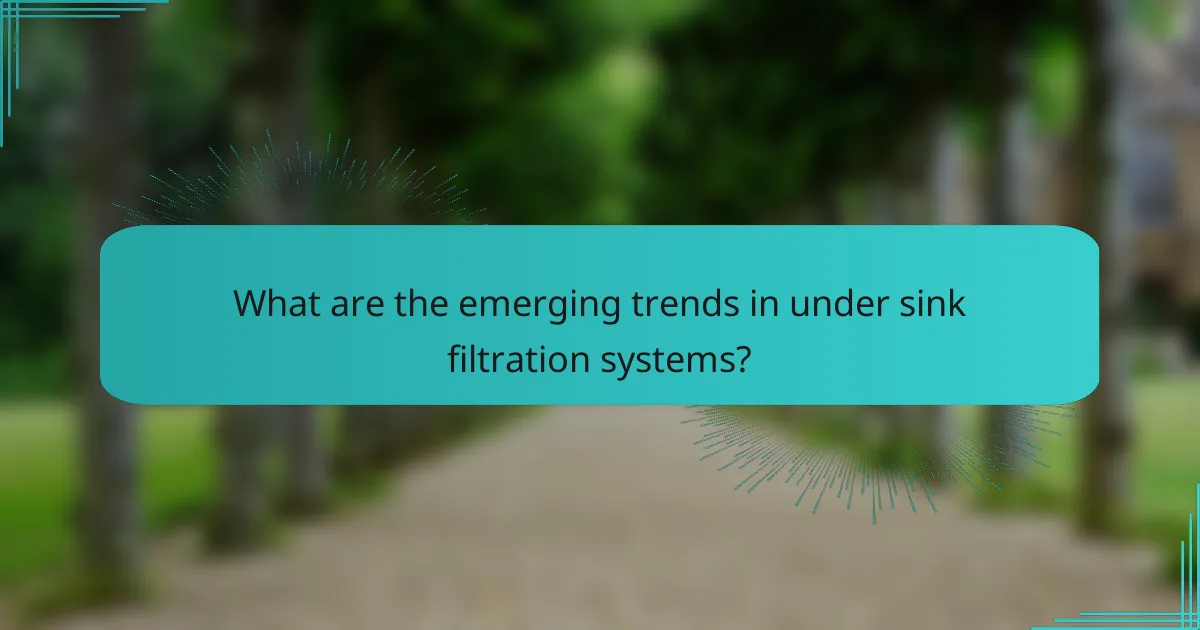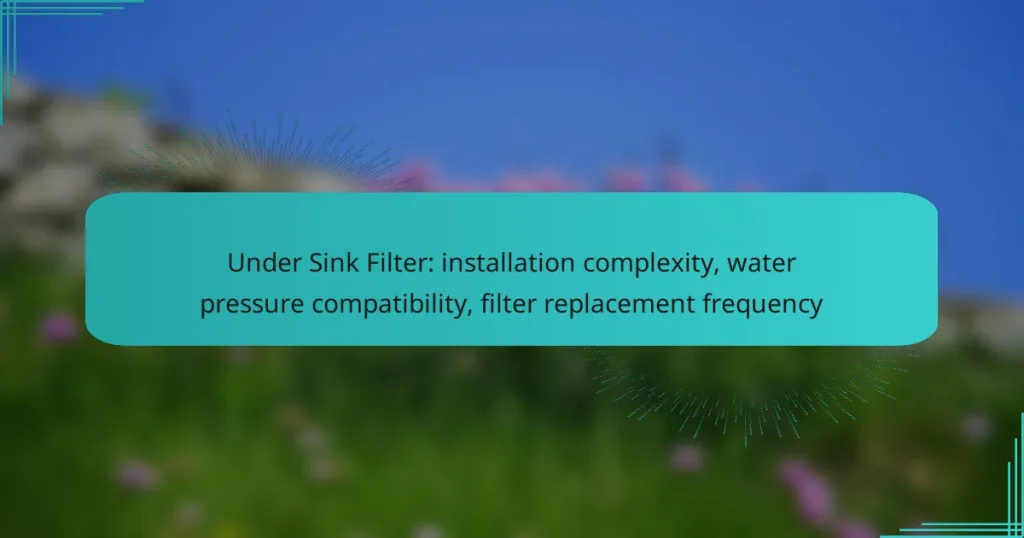Installing an under sink filter can significantly improve your home’s water quality by connecting it to your existing plumbing. It’s essential to ensure compatibility with local water pressure, typically between 40 to 80 psi, for optimal performance. Additionally, regular filter replacements every 6 to 12 months are necessary to maintain effective filtration and ensure safe, great-tasting water.

How to install an under sink filter in London?
Installing an under sink filter in London involves connecting the filter system to your existing plumbing, ensuring compatibility with local water pressure and regulations. Proper installation can enhance water quality and convenience, making it a worthwhile investment for households.
Step-by-step installation guide
Begin by turning off the water supply to the sink. Next, remove the existing faucet if necessary, and install the filter’s mounting bracket under the sink. Connect the filter to the cold water line using the provided fittings, ensuring all connections are secure to prevent leaks.
After connecting the filter, install the new faucet that comes with the filter system. Finally, turn the water supply back on and check for leaks while running the water through the new filter for a few minutes to flush out any impurities.
Required tools and materials
To install an under sink filter, you will need a few basic tools and materials. Commonly required items include a wrench, a screwdriver, Teflon tape, and the filter system itself, which typically comes with all necessary fittings and a new faucet.
Having a bucket on hand can also be useful for catching any water that may spill during the installation process. Ensure you have the specific filter model’s manual for reference during installation.
Common installation challenges
One common challenge is dealing with limited space under the sink, which can make accessing plumbing difficult. If your sink has a complex setup, consider consulting a professional to avoid complications.
Another issue may arise from incompatible water pressure. Before installation, check your home’s water pressure to ensure it aligns with the filter’s requirements, typically between 40 to 80 psi. If your pressure is too low, you may need a booster pump to ensure proper filtration.

What is the water pressure compatibility for under sink filters?
Under sink filters typically require a specific range of water pressure to function effectively, generally between 40 to 80 psi (pounds per square inch). Ensuring your water pressure falls within this range is crucial for optimal filtration performance and longevity of the system.
Recommended pressure range
The ideal water pressure for under sink filters is usually between 40 and 80 psi. This range allows the filter to operate efficiently, providing adequate flow rates while maintaining effective filtration. If your home’s water pressure is below 40 psi, you may need to consider a booster pump to enhance performance.
Effects of low water pressure
Low water pressure, typically below 40 psi, can lead to insufficient flow rates through the filter. This can result in slower water delivery, making it inconvenient for daily use. Additionally, prolonged low pressure may hinder the filter’s ability to remove contaminants effectively, compromising water quality.
Effects of high water pressure
High water pressure, exceeding 80 psi, can damage the filter system over time. Excessive pressure may cause leaks, reduce the lifespan of the filter, and compromise the integrity of the connections. Installing a pressure regulator can help maintain safe levels and protect your under sink filter from potential damage.

How often should you replace an under sink filter?
Under sink filters typically need replacement every 6 to 12 months, depending on usage and water quality. Regular replacement ensures optimal filtration performance and maintains water taste and safety.
Typical replacement frequency
The average replacement frequency for under sink filters is generally between 6 to 12 months. Some filters may last longer, especially those designed for heavy-duty use, which can extend up to 2 years. Always refer to the manufacturer’s guidelines for specific recommendations.
Signs that replacement is needed
Common signs that an under sink filter needs replacement include a noticeable change in water taste or odor, reduced water flow, or visible sediment in the water. If you notice any of these symptoms, it’s advisable to check the filter’s condition and consider replacing it.
Factors affecting replacement frequency
Several factors can influence how often you need to replace your under sink filter. Water quality, usage levels, and the type of contaminants present in your water supply all play significant roles. For instance, households with high sediment levels may require more frequent changes compared to those with cleaner water sources.
Additionally, the filter’s capacity, which is often measured in gallons, can determine its lifespan. Filters rated for higher capacities may last longer, but regular monitoring is essential to ensure continued effectiveness.

What are the prerequisites for choosing an under sink filter?
Choosing an under sink filter requires evaluating water quality, space availability, and plumbing compatibility. Understanding these prerequisites ensures effective filtration and seamless installation.
Water quality assessment
Assessing water quality is crucial before selecting an under sink filter. Test your water for contaminants such as chlorine, lead, and sediment to determine the appropriate filtration system. Many local health departments provide water quality reports, or you can use home testing kits for a more personalized analysis.
Based on the results, choose a filter that targets specific contaminants. For instance, if lead is a concern, look for filters certified to remove lead according to NSF/ANSI standards.
Space and plumbing considerations
Space and plumbing are significant factors in choosing an under sink filter. Measure the area under your sink to ensure the filter system will fit without obstructing plumbing or other appliances. Most under sink filters require a minimum clearance of about 12 inches for installation and maintenance.
Additionally, check your plumbing configuration. Some filters may require modifications to existing pipes or the installation of a dedicated faucet. Ensure that your water pressure is compatible with the filter system, typically requiring a minimum of 40 psi for optimal performance.

What are the best under sink filter brands available in the UK?
Some of the best under sink filter brands in the UK include Brita, AquaCrest, and APEC. These brands are known for their reliability, effectiveness in removing contaminants, and user-friendly installation processes.
Brand comparisons
When comparing under sink filter brands, consider factors like filtration technology, flow rate, and ease of installation. For instance, Brita offers a range of filters that utilize activated carbon, while APEC focuses on reverse osmosis systems that provide thorough purification.
Another aspect to evaluate is the lifespan of the filters. Brands like AquaCrest often provide filters that last longer between replacements, which can save on maintenance costs. It’s essential to weigh these features against your specific water quality needs.
Customer reviews and ratings
Customer reviews for under sink filter brands typically highlight performance, ease of installation, and taste improvement. Brita often receives high marks for its straightforward setup and effective filtration, making it a popular choice among homeowners.
On the other hand, APEC users frequently praise the brand for its comprehensive filtration capabilities, although some note that installation can be more complex. Checking online ratings can provide valuable insights into user experiences and help you make an informed decision.

What are the emerging trends in under sink filtration systems?
Emerging trends in under sink filtration systems focus on advanced technology, sustainability, and smart home integration. These innovations enhance water quality, reduce environmental impact, and offer convenience for users.
Smart filtration technology
Smart filtration technology incorporates sensors and connectivity features that monitor water quality and filter performance in real-time. Users can receive alerts on their smartphones about filter status, usage, and maintenance needs, ensuring optimal filtration at all times.
Many systems now allow for remote control and adjustments, enabling users to customize filtration settings based on their preferences or water quality reports. This technology can significantly improve the user experience and ensure consistent access to clean water.
Eco-friendly filter options
Eco-friendly filter options are becoming increasingly popular as consumers seek sustainable solutions. These filters often use biodegradable materials or are designed for longer lifespans, reducing waste and the frequency of replacements.
Some brands offer refillable filter cartridges, which minimize plastic waste and can be more cost-effective over time. Choosing eco-friendly options not only benefits the environment but can also align with local regulations promoting sustainability.
Integration with home automation systems
Integration with home automation systems allows under sink filtration systems to work seamlessly with other smart devices. This connectivity can enhance water management by linking filtration systems to home water usage data, optimizing performance based on consumption patterns.
For instance, users can automate filter replacements based on usage metrics or receive notifications when water quality drops. This integration simplifies maintenance and ensures that households always have access to safe drinking water.


